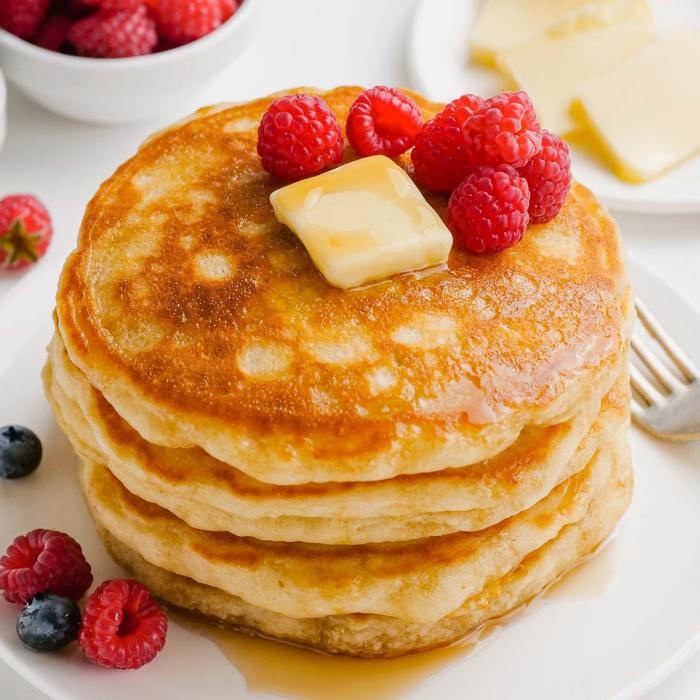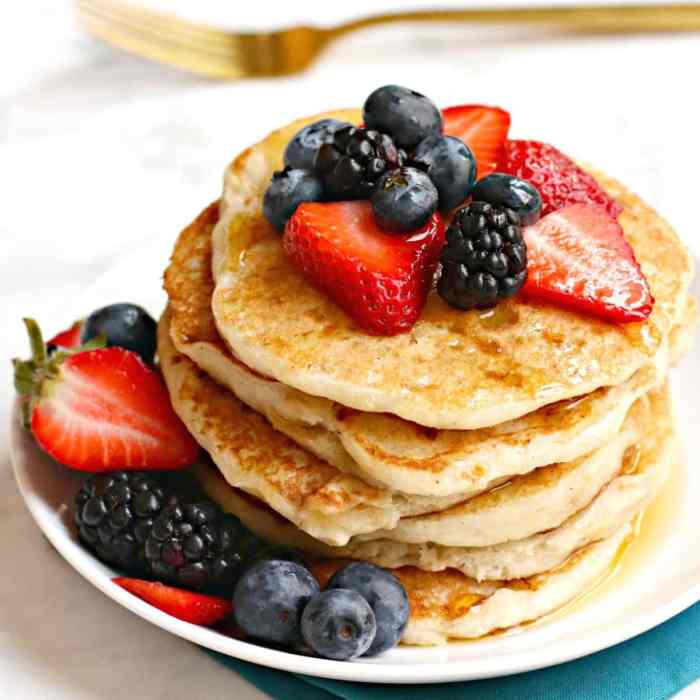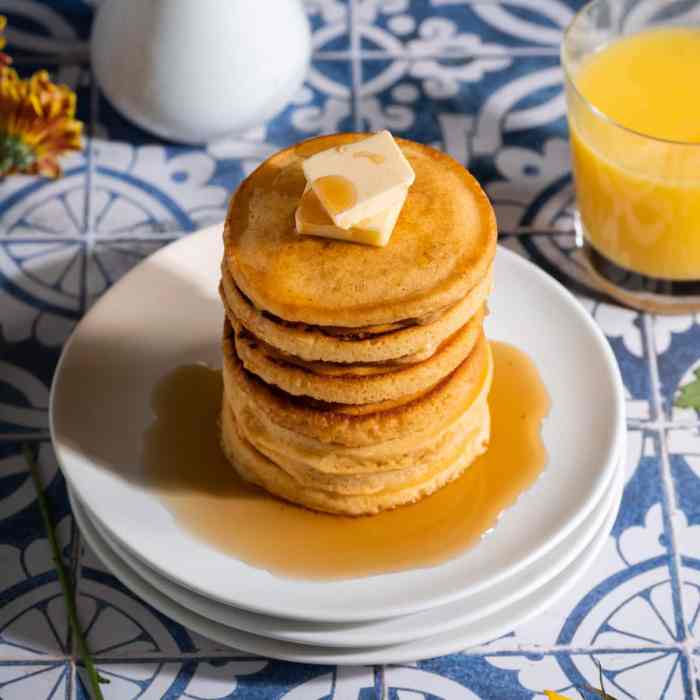Pancake Recipe No Milk: Delicious & Dairy-Free – Dive into a world of fluffy, flavorful pancakes without relying on traditional dairy milk. This guide explores the benefits of milk-free pancakes, introduces alternative milks, and provides a simple yet versatile recipe.
Discover the history of pancakes and how they’ve evolved, and learn how to customize your recipe with various flavor profiles and cooking techniques.
Whether you’re avoiding dairy, seeking new culinary adventures, or simply looking for a healthier option, this comprehensive guide equips you with the knowledge and inspiration to create delightful milk-free pancakes. Get ready to experiment with different milk alternatives, explore unique flavor combinations, and enjoy the satisfying experience of crafting your own perfect stack of pancakes.
Introduction to Milk-Free Pancakes
Pancakes are a beloved breakfast staple enjoyed worldwide. While traditional recipes often call for milk, there are numerous benefits to making pancakes without it. Milk-free pancakes cater to dietary restrictions, allergies, and preferences, offering a delicious and versatile alternative.
Milk Alternatives for Pancakes
Milk alternatives provide a variety of flavors and textures to pancake recipes. These alternatives can be plant-based, dairy-free, or even simply water. Some popular milk alternatives include:
- Almond Milk:This nutty milk provides a subtle flavor and is a popular choice for those with dairy allergies. It is naturally low in calories and fat.
- Soy Milk:A good source of protein and calcium, soy milk is a versatile alternative that blends well with most pancake recipes. It has a slightly beany flavor.
- Coconut Milk:Known for its creamy texture and sweet, tropical flavor, coconut milk adds a unique twist to pancakes. It is naturally high in fat and calories.
- Oat Milk:A good source of fiber and protein, oat milk offers a slightly sweet, creamy flavor. It is also naturally gluten-free.
- Rice Milk:A mild-flavored alternative, rice milk is often preferred by those with sensitive stomachs. It is naturally low in protein and fat.
History of Pancakes
Pancakes have a long and rich history, dating back to ancient times. Evidence suggests that pancakes were a common food in ancient Egypt, Greece, and Rome. These early pancakes were often made with simple ingredients like flour, water, and honey.
The evolution of pancakes over centuries has seen the addition of various ingredients, including eggs, milk, and spices.
Pancakes became a popular breakfast food in Europe during the Middle Ages. They were often served with butter, honey, or fruit. In the 17th century, pancakes were introduced to North America by European settlers. Over time, the recipe for pancakes has evolved to include a variety of ingredients and toppings.
Basic Milk-Free Pancake Recipe

This recipe provides a simple and delicious way to enjoy pancakes without using milk. It’s perfect for those with dairy allergies or intolerances, or simply looking for a different flavor profile.
Ingredients and Their Roles
This recipe uses common pantry staples and highlights the role each ingredient plays in creating a fluffy and flavorful pancake.
- Flour:Provides structure and texture to the pancake.
- Baking powder:Acts as a leavening agent, creating air pockets for a light and fluffy texture.
- Sugar:Adds sweetness and helps to caramelize the pancakes during cooking.
- Salt:Enhances the flavors of the other ingredients and balances the sweetness.
- Eggs:Bind the ingredients together, add richness, and contribute to the texture.
- Water:Activates the baking powder and helps to create a smooth batter.
- Oil:Prevents sticking and adds a slight richness to the pancakes.
Preparing the Batter
Follow these steps to create a smooth and consistent pancake batter:
- Whisk dry ingredients:In a large bowl, whisk together the flour, baking powder, sugar, and salt.
- Combine wet ingredients:In a separate bowl, whisk together the eggs, water, and oil.
- Combine wet and dry ingredients:Gradually add the wet ingredients to the dry ingredients, whisking until just combined. Avoid overmixing, as this can lead to tough pancakes.
- Let batter rest:Allow the batter to rest for 5-10 minutes before cooking. This allows the gluten to relax, resulting in a more tender pancake.
Variations and Flavor Profiles
Milk-free pancakes offer a wide range of flavor possibilities, catering to various dietary needs and preferences. With a little creativity, you can easily transform a basic pancake recipe into a culinary masterpiece.
Flavor Profiles and Milk Alternatives
Here are some common milk-free alternatives and their unique flavor profiles, along with special ingredients that can enhance the overall taste experience:
| Recipe Name | Milk Alternative | Flavor Profile | Special Ingredients |
|---|---|---|---|
| Classic Buttermilk Pancakes | Buttermilk (dairy-free) | Tangy and slightly sour | None |
| Coconut Cream Pancakes | Coconut milk | Sweet and nutty, with a hint of tropical flavor | Shredded coconut, macadamia nuts |
| Almond Milk Pancakes | Almond milk | Mildly nutty and slightly sweet | Almond extract, chopped almonds |
| Oat Milk Pancakes | Oat milk | Slightly sweet and slightly nutty | Cinnamon, maple syrup |
| Soy Milk Pancakes | Soy milk | Slightly sweet and slightly savory | Soy sauce, sesame seeds |
Common Pancake Additions
Beyond milk alternatives, numerous ingredients can elevate your pancakes to new heights. * Fruits:Fresh or frozen berries, bananas, peaches, apples, and even chopped mangoes add sweetness and vibrant color to your pancakes.
Nuts
Chopped walnuts, pecans, almonds, and hazelnuts provide a satisfying crunch and nutty flavor.
Chocolate Chips
Semi-sweet or dark chocolate chips offer a decadent and indulgent twist.
Spices
Cinnamon, nutmeg, cardamom, and ginger can enhance the flavor and aroma of your pancakes.
Customizing Your Recipe
To create unique flavor profiles, experiment with different combinations of ingredients. * Sweet and Savory:Combine banana and cinnamon for a warm, comforting flavor.
Tropical Delight
Remember to click juicing recipes for weight loss to understand more comprehensive aspects of the juicing recipes for weight loss topic.
Use coconut milk and add pineapple chunks and macadamia nuts for a taste of the tropics.
Chocolate Indulgence
Incorporate cocoa powder and chocolate chips for a rich and decadent experience.
Nutty Goodness
Mix almond milk with chopped walnuts and a drizzle of honey for a satisfyingly nutty flavor.
Cooking Techniques and Tips: Pancake Recipe No Milk

Cooking milk-free pancakes requires a few adjustments to achieve the desired texture and browning. Here are some tips and techniques that will help you create delicious pancakes without using milk.
Methods for Cooking Milk-Free Pancakes
There are several methods for cooking pancakes without milk, each with its own advantages and disadvantages.
- Using Water:Water is the simplest milk substitute for pancakes. It adds moisture without affecting the flavor. However, it may result in slightly denser pancakes.
- Using Plant-Based Milk:Almond milk, soy milk, oat milk, and coconut milk are excellent alternatives to dairy milk. They add moisture and flavor, and some even contribute to a fluffier texture.
- Using Yogurt:Yogurt, especially Greek yogurt, can add a tangy flavor and a slightly denser texture to your pancakes. It also provides additional protein.
- Using Applesauce:Applesauce is a great way to add moisture and sweetness to pancakes. It also helps create a denser texture, making them ideal for serving with savory toppings.
- Using Banana:Mashed banana can be used as a milk substitute in pancakes, adding sweetness and moisture. It also contributes to a slightly denser texture.
Achieving the Perfect Texture and Browning, Pancake recipe no milk
The key to perfect milk-free pancakes lies in achieving the right balance of ingredients and cooking technique.
- Use a Non-Stick Pan:A non-stick pan is essential for preventing sticking and ensuring even browning. Make sure the pan is heated to medium heat before adding the batter.
- Use a Ladle or Measuring Cup:Use a ladle or measuring cup to pour the batter onto the hot pan, creating evenly sized pancakes.
- Cook on Medium Heat:Cooking on medium heat allows the pancakes to cook evenly and develop a golden brown crust. Avoid cooking on high heat, as this can lead to burning.
- Flip Once:Once bubbles appear on the surface of the pancake and the edges start to solidify, it’s time to flip. Flipping too early can result in a soggy pancake, while flipping too late can lead to burning.
- Cook Until Golden Brown:Cook the pancake on the other side until it’s golden brown and cooked through. You can test for doneness by gently pressing the center of the pancake. If it springs back, it’s done.
Troubleshooting Common Issues
While making milk-free pancakes, you might encounter some common issues.
- Pancake Sticks to the Pan:This can happen if the pan isn’t hot enough, the batter is too wet, or the pan isn’t properly greased. Increase the heat, adjust the batter consistency, or use more cooking spray or butter.
- Pancake Falls Apart:This can occur if the batter is too thin or overmixed. Add a little more flour or reduce the amount of liquid in the batter. Avoid overmixing the batter, as it can lead to tough pancakes.
- Pancake is Too Dense:If your pancakes are too dense, you may have used too much flour or overmixed the batter. Reduce the amount of flour or use a lighter milk substitute. Be careful not to overmix the batter.
- Pancake is Too Thin:If your pancakes are too thin, you may have used too much liquid or not enough flour. Add a little more flour or reduce the amount of liquid in the batter. Adjust the consistency of the batter to ensure it’s thick enough to hold its shape.
Serving and Presentation
The way you present your milk-free pancakes can elevate the experience from simple breakfast to a culinary delight. Consider creative serving ideas, toppings that complement the flavor, and visually appealing plating techniques to make your pancakes memorable.
Toppings and Accompaniments
Toppings and accompaniments are essential for adding flavor and texture to your milk-free pancakes.
- Sweet Toppings:Consider classic favorites like maple syrup, honey, fruit compotes, and chocolate sauce. For a more sophisticated touch, try flavored syrups like caramel, pecan, or vanilla bean. Fresh fruit slices, berries, or chopped nuts add a touch of freshness and crunch.
- Savory Toppings:For a savory twist, explore toppings like avocado slices, crumbled bacon, sautéed mushrooms, or a dollop of sour cream. A sprinkle of herbs like chives or parsley adds a touch of freshness.
Plating and Presentation
The way you plate your pancakes can make a big difference in their visual appeal.
- Stacking:Stack pancakes in a tower for a classic presentation. Use a small plate or a tiered stand to showcase the height.
- Fanning:Fan out pancakes in a circular pattern on a plate for a more modern look. This allows you to showcase the texture and color of the pancakes.
- Garnishes:Add a touch of elegance with garnishes like fresh mint sprigs, edible flowers, or a drizzle of chocolate sauce.
Nutritional Considerations

While milk-free pancakes offer a delicious and adaptable breakfast option, it’s essential to consider their nutritional profile and how they compare to traditional recipes. By understanding the differences, you can make informed choices and enjoy a nutritious and satisfying meal.
Nutritional Value Comparison
Milk-free pancakes often differ in nutritional content compared to traditional recipes that use cow’s milk. The primary differences lie in the protein, fat, and carbohydrate content.
- Protein:Traditional pancakes, made with cow’s milk, typically have a higher protein content due to the milk protein casein. Milk-free alternatives, such as almond milk or soy milk, generally have lower protein levels. To compensate for this, you can add a scoop of protein powder or incorporate additional protein sources like nuts or seeds into the batter.
- Fat:The fat content in milk-free pancakes can vary depending on the alternative milk used. For instance, almond milk is naturally low in fat, while coconut milk contains more saturated fat. It’s essential to check the nutritional information of your chosen milk alternative to understand its fat profile.
- Carbohydrates:The carbohydrate content in milk-free pancakes is usually similar to traditional recipes, primarily coming from the flour used. However, some alternative milks, like oat milk, may contain slightly more carbohydrates due to their naturally higher sugar content.
Potential Health Benefits of Alternative Milks
Using alternative milks in your pancake recipe can offer several potential health benefits.
- Lactose Intolerance:For individuals with lactose intolerance, milk-free pancakes are a great option as they eliminate the lactose found in cow’s milk.
- Reduced Cholesterol:Some alternative milks, like almond milk, are naturally low in saturated fat and cholesterol, potentially contributing to a healthier heart.
- Nutrient-Rich Options:Certain alternative milks, such as soy milk and oat milk, are fortified with vitamins and minerals, providing additional nutritional value.
Tips for Making Pancakes Even Healthier
While milk-free pancakes can be a nutritious choice, incorporating a few simple tips can make them even healthier.
- Whole-Wheat Flour:Use whole-wheat flour instead of refined white flour to increase fiber content and provide a more complex carbohydrate source.
- Add Fruits and Vegetables:Incorporate chopped fruits like berries or bananas, or grated vegetables like zucchini or carrots, into the batter for added vitamins, minerals, and fiber.
- Limit Sugar:Use natural sweeteners like maple syrup or honey in moderation. You can also try using unsweetened alternative milks to further reduce sugar content.
- Healthy Toppings:Choose healthy toppings like fresh fruit, nuts, seeds, or a drizzle of honey instead of sugary syrups or butter.
Closing Notes
Mastering the art of milk-free pancakes opens a door to a world of culinary possibilities. By understanding the benefits of milk alternatives, exploring different flavor profiles, and perfecting your cooking techniques, you can create a delicious and satisfying breakfast experience.
From classic buttermilk pancakes to innovative fruit-infused variations, the world of milk-free pancakes is ripe for exploration. So, embrace the freedom of dairy-free baking, and enjoy the journey of crafting your own unique pancake creations.
